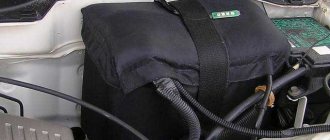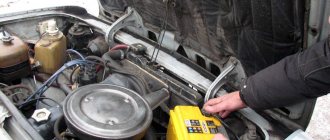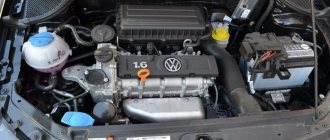If you remove the terminal from the battery while the engine is running on different cars, you can get several different outcomes of the event. That is why nothing happened to one car enthusiast during such actions, to another the car stalled, to a third it then started, and to a fourth it no longer shows signs of life. Accordingly, the latter has even more possible scenarios for the development of events - now go and find the reason why it won’t start.
This article examines all these situations from different perspectives. Why does the car stall? Why doesn't it stall? Why did it stall for one after removing the terminal while the engine was running, but start again, while for the other it “decided to live for a long time.” What burned out and why? It is also explained in detail and with clear examples why it is not worth removing the terminal while the engine is running, to put it mildly.
How will removing the battery affect a modern car?
We are glad to see useful advice on our website, and today you have the following question: is it possible to remove the battery from the car? Let’s look into this in more detail.
Almost every driver in his practice has encountered a situation where it was necessary to remove the battery or disconnect the terminals. In most cases, when dismantling a battery, car enthusiasts do not think about how serious the consequences of performing this operation incorrectly can be. Let's look at the most common mistakes and possible consequences.
We recommend: What should you be wary of in a “garage” car service?
Is it possible to remove the battery with the engine running?
And this is a truly controversial situation, dividing the army of car owners into two camps. Some believe that there is nothing dangerous in this, others believe that this act will certainly lead to serious consequences such as burnt-out equipment.
As often happens in such cases, the truth is somewhere in the middle.
That is, you can disconnect the battery while the car is running, but carefully, and only in cases where you cannot do without it. An example of such a case is a battery that is completely discharged, when there are no wires for lighting, and the only way to start the engine is to use a neighbor’s battery, which needs to be returned without turning off the engine.
So, let's look at the unpleasant moments that can happen.
Short circuit
When the engine is running, the battery is fed from the generator, that is, current flows to its positive terminal. Therefore, if it becomes necessary to remove the battery, do not allow the positive wire to touch the body or any other metal part of the engine compartment! Otherwise, a short circuit occurs, and literally in a split second the working electronics can burn out, and if you hesitate, the wiring can also burn out with the risk of ignition and a fire. Remember that the generator produces high currents, which are transmitted through the wire with the positive terminal. If it touches the body, which is connected by ground to the negative terminal of the battery, the circuit will close on itself. This phenomenon is called a short circuit.
Voltage drops
Many, even experienced motorists, are convinced that if you remove the battery while the car is running, there is a possibility that the equipment will burn out from a power surge. This is, to put it mildly, misleading. The fact is that the generator initially produces electricity, the amount of which depends on the speed of rotation of its shaft, that is, on the engine speed. And they are not constant, so generators are equipped with a voltage regulator in order to stabilize this parameter at the output. That is, no matter how fast the crankshaft rotates, the output voltage of the generator will not exceed 14.4–14.5 V. Removing the battery may well cause voltage fluctuations, but not dangerous in amplitude. If you want to play it safe, just turn on additional equipment to the maximum - air conditioning, headlights, heated windows - in this case, the voltage in the network will drop even more, down to 13.7–13.8 V, which is completely harmless for electronics.
It is worth considering one more point. The battery is not constantly charged from the generator. If it is already charged, then no current flows from the generator to it. What voltage surge can be expected in this case?
Wiring
Another myth is the statement that if you remove the battery from a running car, the wiring may burn out. The reasoning here is similar to the previous case: the relay-regulator will make sure that the voltage supplied to the battery is low, and even if the condition of the terminals is unimportant (they are dirty, oxidized), this will not lead to heating of the contact group or wiring. So none of the parts of the battery-generator subsystem should be damaged when removing the battery while the engine is running. The main thing is to monitor the positive wire and prevent it from touching the body.
Violation of the battery terminal removal sequence
First you need to remove the positive terminal, then the negative one. This sequence is primarily necessary for safety reasons. If you first disconnect the positive terminal using an open-end wrench (usually 10), the metal wrench may short the +12 Volt terminal to the body of the car. A short circuit will occur. A short circuit in the battery may result in:
We recommend: REMOVAL OF BITUMEN STAINS FROM CAR BODY
· thermal damage from a hot key;
· eye damage as a result of sparking;
· chemical burns, which may result from a battery explosion;
· failure of the vehicle's electrical equipment;
· car ignition.
The procedure for preparing the battery for winter
It's getting colder outside, winter is coming, and this means that the battery needs to be prepared for use in extreme conditions. For those drivers who avoid traveling in winter and prefer to use public transport at this time, the issue is resolved simply. It is enough just to disconnect the battery for the winter and ensure it is stored in a warm room.
In other cases, it is necessary to remove the battery and carry out a series of battery maintenance activities. These measures are mandatory to prevent unpleasant surprises, because at negative temperatures the battery capacity decreases, the load capacity drops, and cold starting with increased oil viscosity in the engine is greatly complicated.
Checking the electrolyte level. First of all, you need to clean the contacts and battery case, and then check the electrolyte level. To do this, you need to unscrew the plugs from the filler holes and make sure that the electrolyte level in each of them is between o and “maximum”. If there are no such marks, visual inspection can be carried out.
The electrolyte level in each jar should be 10-15 mm above the plates. If it is lower, you should add distilled water.
Charger. A special device is used for charging. If there is a question about purchasing such a device, then it is better to pay attention to the presence of an automatic mode.
Otherwise, you have to control the charging process itself. In this case, the charging current should be 0.1 of the capacity. For example, if the capacity is 60 A/h, then the current will be 6A. When the voltage rises to 14.5V, the current must be halved and charging continued for another ten hours.
Electrolyte density. This check is carried out after full charging and standing for at least one hour. For this purpose, a special device is used, called an ariometer.
The test is carried out at a temperature of 20°C. If it is different, you must be guided by the table attached to the ariometer. The density of a charged battery must be at least 1.27 g/cm 3 . If this parameter is lower, it is necessary to add electrolyte, the density of which is increased. It is sold in auto stores.
Voltage. The final step in preparing the battery is to check the voltage, which for normal engine starting must be at least 12.6V.
Experts recommend checking the battery charge monthly in winter, and the level and density of the electrolyte – weekly. In regions with severe frosts, as an additional measure in preparation for winter, you need to insulate the battery.
The rules for handling batteries are simple and following them will eliminate possible troubles, both with the battery and with the car itself.
Mechanical loads when removing the battery
Excessive mechanical loads can lead to damage to the battery case and the formation of cracks.
In addition to the listed consequences, in some cars, after removal, the settings of the car radio, additional equipment, on-board computer, and other electronic devices are reset.
We recommend: Car battery maintenance
When dismantling, you should pay attention to the connection of the gas outlet (a special hose for removing gaseous charge-discharge products in the battery banks). Most often it is installed when the battery is located in the passenger compartment or trunk. If the gas outlet is not connected during further installation of the battery, harmful gases will enter the cabin and corrosion processes will intensify.
When installing the battery, special attention must be paid to checking the correct polarity. If the battery polarity is reversed, serious damage to electronic equipment and the generator may occur.
Disconnecting the battery in the car. Work order.
Disabling a car battery is a standard operation that every driver has to deal with. The main reasons that force you to disconnect the battery terminals on a car are the need for maintenance, increased discharge current during parking, welding work on the car, preparation for winter, various repair work that requires de-energizing the electrical equipment system, and others.
Many drivers disconnect the battery after each trip, especially in cases where trips do not occur every day or the travel mode is such that it does not allow the battery to be fully recharged from the generator, for example, trips over short distances with a large number of stops, when the engine is turned off, and then starts again, driving in traffic jams. Or, for example, traveling in the dark, and even in winter, when all the lighting and heating devices of the car operate at full power, not giving the battery time to fully recharge while driving. Of course, in all these cases, disconnecting the battery is an additional measure to preserve the charge and at least some guarantee that the car will start in the morning. The best option in these cases would be to periodically charge the battery.
Algorithm of actions
There are several ways to remove the battery. Car enthusiasts have found the most effective one and recommend using this particular algorithm when removing the battery.
- First of all, it is necessary to warm up the battery to normal temperature when it is in operation; it is recommended to do this while moving.
- Next, you need to remove the negative terminal and wait for the computer to reset, 3 minutes is enough. Then the terminal is put back. If the battery has been completely taken out of the car, you must first connect the positive one.
- Then, without touching the pedal - this is very important, you need to start the engine and warm it up for 10-15 minutes. During this time, information will be collected from the on-board system sensors.
- After 15 minutes the ignition is turned off to allow data recording to take place.
- Next, the car starts and accelerates to a speed of approximately 50-60 km/h, followed by a complete stop.
- The ignition is turned off again, this time the computer records the readings of the sensors operating in motion.
When using a car for a long time, it often happens that the computer memory produces false codes, signaling various malfunctions - errors that affect the car. To get rid of the problem, you need to periodically reset the computer by removing the terminals. Everything seems simple, however, the risk of harm is high, so be sure to approach the process prepared and with extreme care.
Precautionary measures
To prevent the procedure for removing the battery with your own hands from ending in trouble for the car owner, he should follow a number of rules:
- Over time, the terminals may oxidize. And in order to remove them, some owners often hit them with a heavy object at hand. But under no circumstances should you do this. This can lead to their permanent failure, or they will fall apart into smaller parts and are highly likely to cause complete breakdown of the battery.
- After removal, the battery must be handled with care. Don't throw or kick her. Otherwise, this may cause electrolyte leakage or cause damage to the active mass.
- Do not place the battery on its side or upside down. Such a ban is due to the risk of leakage of electrochemical fluid and even short circuit.
- Do not drain electrolyte from cans. It contains sulfuric acid and distilled water, which can cause burns if in contact with skin or clothing. This procedure must be carried out only in specially prepared places.
- Do not add acid or electrolyte. This can only be done during special restoration work. In all other cases, the level of density may increase significantly, and this is fraught with sulfation of the plates. Only purified water can be added.
- Under no circumstances should you store a completely discharged battery in the cold. If it freezes, this can provoke shedding of the active mass, which most often happens in half of the cases.
Every car owner should memorize these rules and follow them exactly, and if necessary, learn in advance how to properly disconnect the car battery. You need to be especially careful with the battery, which after removal should be carefully placed on the ground and under no circumstances thrown.
Operating a car involves more than just pleasant moments for the car owner. But often it is necessary to carry out other procedures. One of them is removing the battery. Although in some cases this operation is simply necessary, it is not worth resorting to in the absence of an urgent need. After all, the battery can affect the operation of other important systems, and not always for the better. Therefore, before removing the battery from the car, you need to make sure that there are serious reasons for this.
We recommend: Rocket car battery: characteristics of a Korean battery
In general, this procedure is not complicated. Even a novice car owner can cope with this task. But in any case, it won’t hurt to prepare for it, study the theoretical aspects of its correct implementation, and find out how to properly disconnect the battery terminals. After all, knowing certain secrets, including the sequence of removing terminals from the battery, will help not only complete this procedure as quickly as possible, but also avoid serious problems associated with the operation of other important car systems.
This is especially true when the battery is planned to be removed from luxury cars. Therefore, if a person does not have experience in dismantling the battery from such a vehicle, then it is better not to take risks, but to entrust this work to experienced specialists from an official service. This will not only save a lot of time and effort, but also avoid unpleasant moments caused by incorrectly carrying out this necessary procedure.











